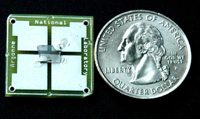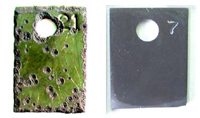|
||
      |
Features ::
Argonne Almanac
Research we use
Chartered to study peaceful uses of atomic power, Argonne initially conducted research with a nuclear focus; the USS Nautilus, the world’s first nuclear-powered submarine, got its power from a nuclear reactor built by the Westinghouse Corporation at Argonne National Laboratory-West. Meanwhile, the lab’s Experimental Breeder Reactor II (EBR-II), offered a prototype for many commercial nuclear-energy plants.

Nanotechnology built an ultrafast hydrogen sensor (above); a resistant alloy (below) may save the hydrogen industry millions.

As Argonne’s mandate has expanded, so has its inventive mode. Included in a long list of accomplishments: lab researchers developed the first automated system for continuous growth of human cells in culture. Argonne scientists tested the world’s first large superconducting magnet. A lab researcher came up with the idea of excimer laser surgery, combining the laser’s near-ultraviolet light with fiber optics. The result: new and safer procedures, such as removing plaque from artery walls.
The lab’s Energy Systems Division won several awards for a process that cuts the cost of manufacturing ethyl lactates, the basis for “green solvents”—environmentally friendly, biodegradable substances to replace more toxic solvents in a range of industrial and consumer uses. Grancrete, an inexpensive spray-on ceramic cement codeveloped by an Argonne scientist, offers long-lasting, easily maintained housing to many people worldwide who cannot now obtain adequate shelter.
The creative spark continues. In listing 2005’s top 100 scientific and technological innovations, R&D Magazine named five new ideas from Argonne, including two—a separative bioreactor for producing and recovering biobased products and improved techniques for X-ray and nuclear imaging—developed with industrial partners. Also recognized by R&D: a fast, cost-effective sensor to detect unsafe hydrogen levels in cars; multiport dryer technology to improve efficiency in paper mills, and metal-dusting resistant alloys, used to make more durable hydrogen-manufacturing equipment.
At the Advanced Photon Source (APS), X-ray crystallography studies done by the Industrial Macromolecular Crystallography Association led to the design of Abbott Laboratories’ Kaletra, now the most-prescribed drug in its class for AIDS therapy. Meanwhile the APS’s Structural Biology Center has reduced the average cost of using X-rays to solve protein structures from $300,000 to $60,000 per structure and sliced the time from months to days; the center has contributed some 1,000 structures to the Protein Data Bank, leading the world in the number of PDB deposits.
Then there’s the low-tech but highly effective Argonne Anti-Jet-Lag Diet (www.AntiJetLagDiet.com) used by hundreds of thousands of travelers over the past 20 years. Research shows that travelers who follow the reset-your-inner-clock diet are seven times less likely to experience jet lag when traveling west and 16 times less likely when traveling east.—M.R.Y.
Intro | Interview | Research We Use | Facility Services | Argonne Numbers | Argonne Chronology